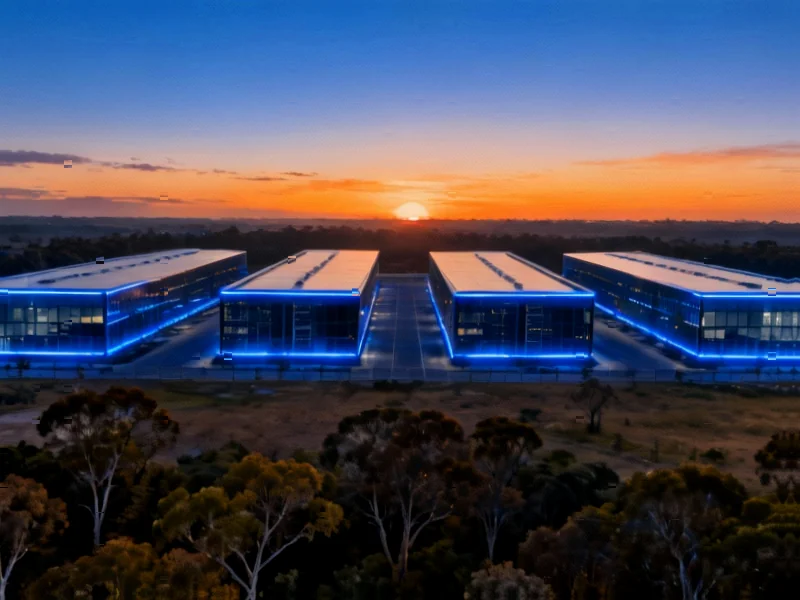Major AI Data Center Cluster Breaks Ground in Wisconsin
OpenAI, in partnership with Oracle and Vantage Data Centers, is launching a significant new data center development in Port Washington, Wisconsin, marking the fifth planned Stargate facility in the United States. The project, codenamed ‘Lighthouse,’ represents a strategic expansion of AI infrastructure beyond traditional technology hubs and is projected to reach nearly one gigawatt of capacity upon completion in 2028.
Table of Contents
Strategic Expansion of Stargate Network
The Wisconsin facility joins the existing Abilene, Texas flagship campus and three other planned Stargate locations in Doña Ana County, New Mexico, and Shackelford County, Texas. When complete, the combined US Stargate network will represent approximately 4.5GW of IT capacity, with the Shackelford County facility alone expected to reach 1.4GW. This expansion underscores the massive computational requirements of next-generation AI systems and the infrastructure needed to support them., according to expert analysis
“Expanding Stargate to Wisconsin is another major step toward building the infrastructure that will help ensure everyone can benefit from AI,” said Peter Hoeschele, OpenAI’s vice president of industrial compute. “This project will create good jobs, advance zero-emission energy, and boost the local economy — all while expanding capacity without raising rates for local consumers.”, according to emerging trends
Sustainable Development and Environmental Stewardship
Vantage Data Centers is taking a comprehensive approach to environmental responsibility at the Wisconsin site. The company plans to develop only 500 of the 672 total acres, preserving the remainder for natural biodiversity. The development includes planting more than 2,000 native trees and creating an eight-foot planted berm with native species for natural sound mitigation.
The campus will feature closed-loop liquid cooling systems and commit to achieving water positivity through investments in local water restoration projects. For power generation, Vantage will deploy net-new solar, wind, and battery storage capacity, with WEC Energy Group indicating the renewable deployment will eventually grow to nearly two gigawatts., according to recent studies
Economic Impact and Community Benefits
The Lighthouse project represents a substantial economic opportunity for Wisconsin and the broader Upper Midwest region. Construction is expected to employ more than 4,000 predominantly union skilled workers, with over 1,000 long-term positions created upon completion. Vantage has committed to a minimum $175 million investment in regional infrastructure upgrades, including expanded water and wastewater treatment capacity, upgraded water mains and sewer lines, a new water tower, and enhanced power infrastructure., as our earlier report, according to recent research
“As demand for data centers expands beyond traditional hubs, the upper Midwest has become a critical and strategic market for Vantage Data Centers and our customers,” said Dana Adams, president of North America for Vantage Data Centers. “Our investment in Wisconsin reflects the area’s strong foundation for digital growth to support sustainable AI innovation at scale.”
Power Management and Rate Protection
In response to growing concerns about data center energy consumption impacting consumer electricity prices, Vantage has implemented a protective rate structure. The company will underwrite 100% of the power infrastructure investment through a dedicated electricity rate from WEC Energy Group utility We Energies. This approach is specifically designed to shield other customers from potential price increases resulting from the new infrastructure investments required to serve the Lighthouse campus.
While the renewable energy deployment is substantial, it’s not expected to cover all of the campus’s power requirements initially. The remaining energy needs will likely be met through fossil fuel sources, with renewable energy purchases used to annually match consumption through renewable energy certificates and similar mechanisms.
Regional Transformation and Future Implications
The selection of Wisconsin for this major AI infrastructure project signals a broader shift in data center geography. The Upper Midwest offers several advantages for large-scale computing operations, including available land, reliable power infrastructure, and favorable climate conditions for cooling efficiency. The Lighthouse project positions Wisconsin as an emerging hub for AI innovation and could attract additional technology investments to the region.
The development also highlights the evolving partnership models between technology companies, data center operators, and utility providers. The collaboration between OpenAI, Oracle, Vantage Data Centers, and We Energies demonstrates how complex infrastructure projects can be structured to balance technological advancement with community and environmental considerations.
As construction begins on the Lighthouse campus, industry observers will be watching closely how this model of sustainable data center development evolves and whether it establishes new benchmarks for future AI infrastructure projects nationwide.
Related Articles You May Find Interesting
- Tesla’s AI Ambitions and Leadership Stability: The Musk Factor in Q3 Earnings an
- We let OpenAI’s “Agent Mode” surf the web for us — here’s what happened
- Tesla Q3 Earnings Fall Short as Analysts Weigh Future Prospects Amid AI Transiti
- Texas Instruments Signals Cautious Outlook as Semiconductor Recovery Loses Momen
- GrapheneOS Hardware Launch: A Security Paradigm Shift for Industrial Mobile Comp
This article aggregates information from publicly available sources. All trademarks and copyrights belong to their respective owners.
Note: Featured image is for illustrative purposes only and does not represent any specific product, service, or entity mentioned in this article.



